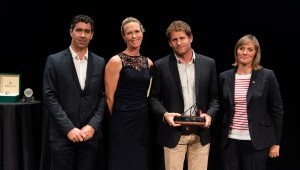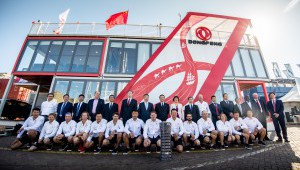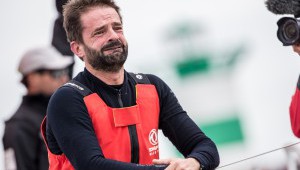The celebrations during those first precious minutes were very special as Charles Caudrelier and his crew, both on the boat and on shore, washed away months of frustration, stress and worry and reveled in their moment of glory.
There were hugs, tears, smiles and cheers as the giant Volvo Ocean Race trophy was handed from one sailor to the other and held aloft; there were flowers and champagne and very quickly Dongfeng’s decks were heaving with husbands and wives, children, shore crew and other friends of this happy team.
It was perhaps Jack Bouttell, Dongfeng’s bowman, who summed it best when he said that in the instant that the Chinese-flagged Volvo Ocean 65 crossed the line all the agonies of the last eight months just vanished. Suddenly it came into sharp focus that this campaign had finally delivered what it had promised for so long.
Of course this was a special celebration not just because the team had won sailing’s world championship of fully-crewed offshore ocean racing, but also because Dongfeng Race Team had finally won a leg. For months Charles and Pascal and their fellow sailors had watched others celebrate at the end of legs and now it was their turn.
On the foredeck, taking it all in, Bruno Dubois, the Team Director who has masterminded this second successive entry by Dongfeng Motor Corporation in the Volvo Ocean Race, was joking that maybe this was all a dream and he would wake up and discover someone else had won. But in reality Dubois always knew that his crew would never give up until the last mile of the last leg. Winning was always the plan.
Having watched this team from close-up and from afar during this long race, that is the main impression one has of it. It was a very tight-knit unit that never allowed its collective head to go down. Charles and Bruno had selected compatible people who could race hard, endure horrendous conditions for weeks on end and suffer big disappointments yet not allow any of that to defeat them. They may have been over-cautious at times but they established a mode of sailing that struck the right balance between speed and stress on the boat – Dongfeng suffered almost no serious damage in 45,000 miles of battle, save for a keel issue on Leg 3.
Talking to the sailors on the dockside it was clear that the toughest moment of the entire race was that horrible finish into Newport, Rhode Island at the end of Leg 8, after Dongfeng had sailed an excellent leg from Itajai in Brazil. With 15 miles to go to the finish she was leading. By the time she eventually crossed the line, having drifted in windless conditions and strong tide in the dark, she was fourth. It was a body blow that would have sunk others, yet somehow Charles and everyone else got back up and returned to fight on.
Bruno himself identifies the Auckland stopover as a turning point. By that stage in the race the team was pretty exhausted after the tough tropical legs from Melbourne to Hong Kong and then back down to New Zealand. But during that stopover the sailors got plenty of rest, had time with their families and then got together for some team building sessions when they relaxed together - for example, on a visit to Waiheke Island – and this proved hugely beneficial in re-defining the crew’s competitive edge. Bruno told them at that stage that the rest of the race was either going to be the “road to hell” or the “land of opportunity” and they chose to view it as the latter.
The other thing about that dramatic afternoon in The Hague were the mind-blowing details of the final 100 or so miles. What a tactical call they made. It will go down as one of the most remarkable decisions in professional sailing history – “when Dongfeng went inshore when the title was at stake in the dying hours of the Volvo Ocean Race 2017-18.” Just consider this: with 117 nautical miles to go, Dongfeng was just over 50 miles behind then then leader, MAPFRE. Yet by the finish, aided by fresher breeze along the coast, a better wind angle than the boats offshore and shallower water – and thus less strong foul tide - she finished three miles ahead of the Spanish boat. It was like wining sailing’s National Lottery.
As others have said, this was a decision that took guts to carry out and indeed Xabi Fernandez’s team on MAPFRE flirted with this option briefly before bailing out. How they must regret that now…But it was very noticeable how happy both Charles and Pascal were to hand the credit to the team’s meteorologist, Marcel van Triest, who had persuaded them before the leg started in Gothenburg to look at the inshore route very carefully and be prepared to take it.
On the dockside at The Hague the waves of happiness engulfing Dongfeng were matched by the desolation on MAPFRE and Team Brunel, but everyone in Charles’s team knows how hard those two crews pushed them right until the end. As MAPFRE came in to tie-up, many of Dongfeng’s crew took time to welcome them in, clapping them as they did so – a final gesture of the sort of good sportsmanship that had characterised the way Dongfeng Race Team had approached this campaign from the start.
Written by Ed Gorman














